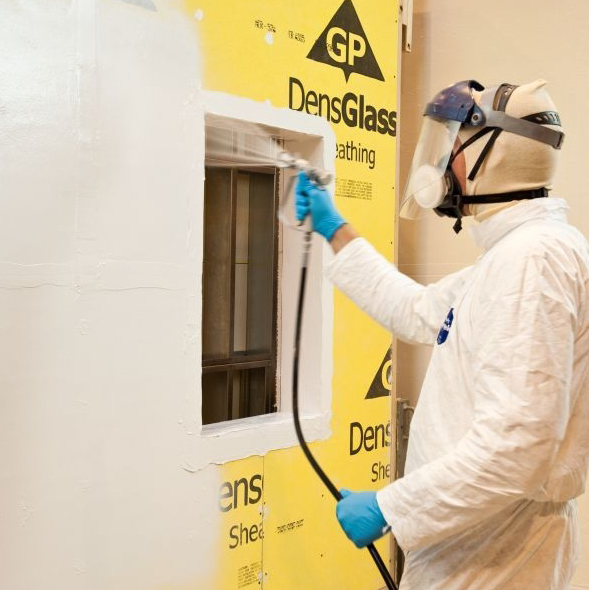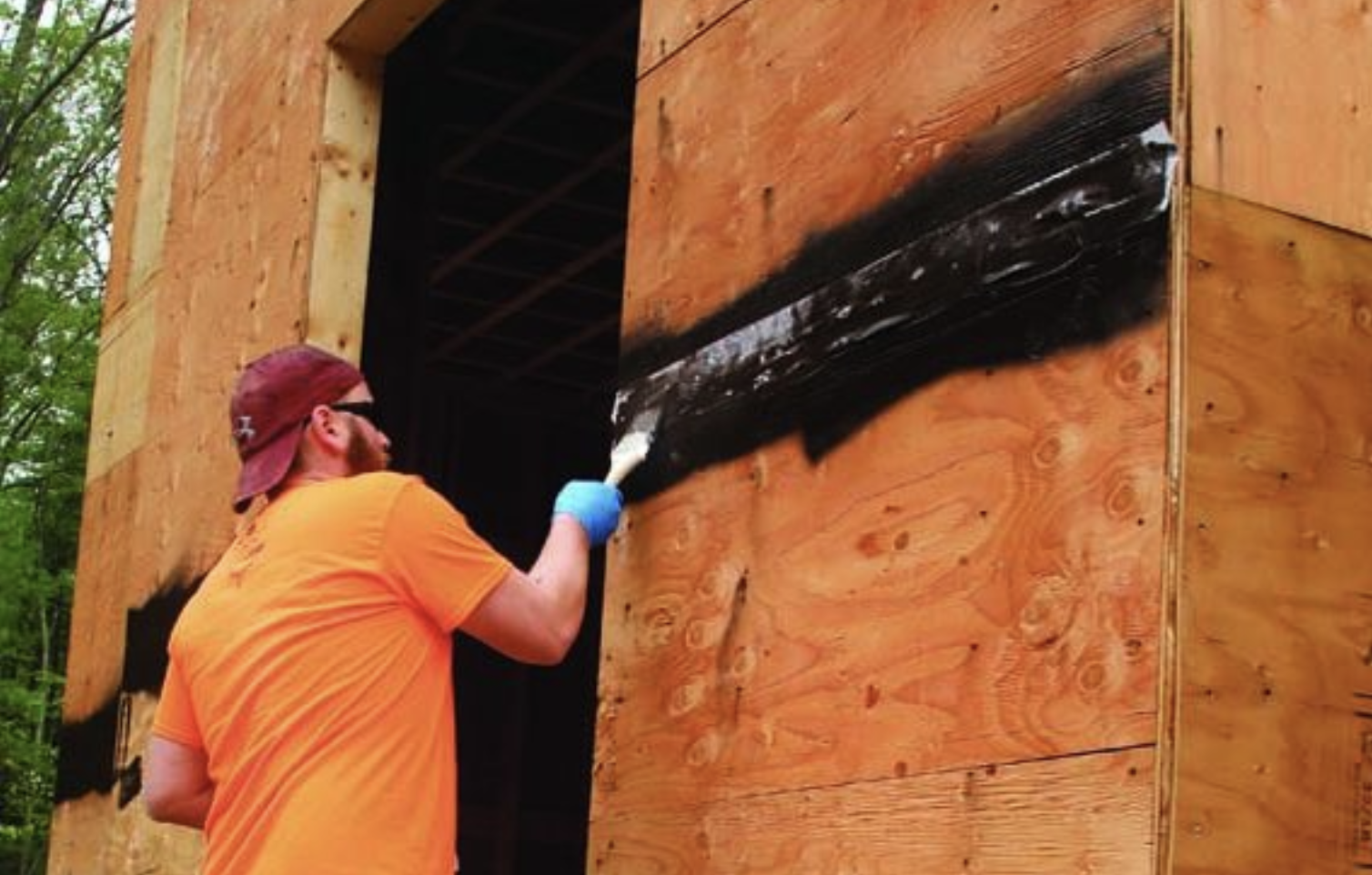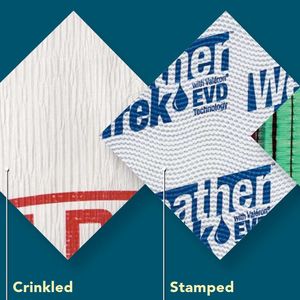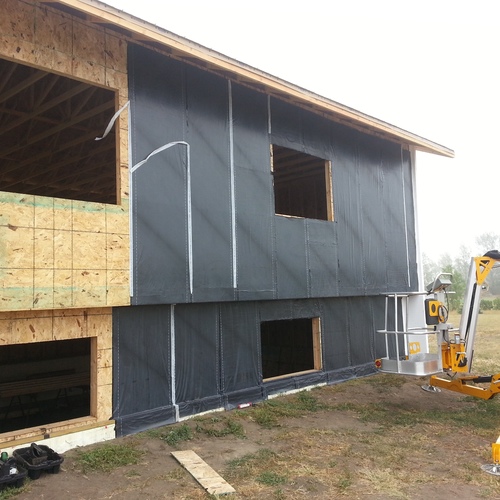
Image Credit: DuPont
When it’s time to cover wall sheathing with a water-resistive barrier (WRB), most residential builders choose plastic housewrap, asphalt felt, building paper, or rigid foam sheathing. Some commercial builders, however, choose a fifth option: a liquid-applied building wrap.
Liquid-applied WRBs come in a bucket and are applied to wall sheathing or concrete blocks with a roller or a spray rig. These products cure to form a tenacious, flexible coating that seals small cracks and penetrations.
Although liquid-applied WRBs cost more than housewrap, they also perform better. Once cured, these rubbery coatings have a major advantage over housewrap or asphalt felt: they provide a very high level of airtightness. While the cured films are highly resistant to water penetration, they are fairly permeable to water vapor. In other words, a wall coated with a liquid-applied WRB can still dry to the exterior.
For builders who prefer to establish a home’s air barrier at the sheathing layer, liquid-applied WRBs are a good alternative to Zip System sheathing.
A decade of proven performance
The Sto Corporation was the first manufacturer to develop a liquid-applied WRB (StoGuard) that is vapor-permeable. Released in 2000, StoGuard remains the market leader. Sto’s competitors include W. R. Grace (the manufacturer of Perm-A-Barrier VP), Henry Company (the manufacturer of Air Bloc 31), DuPont Tyvek (the manufacturer of the Fluid Applied WB System), and Tremco (the manufacturer of Enviro-Dri). GBA’s review of Enviro-Dri was published in July 2012.
I’ll take an in-depth look at two of these products — the ones manufactured by Sto and DuPont.
A code-approved alternative
According to the ICC Evaluation Service, StoGuard is an acceptable alternative to water-resistive barriers specified in the International codes. (Manufacturers interesting in getting code approval for a liquid-applied WRB must submit evidence to the ICC-ES that their product complies with…
Weekly Newsletter
Get building science and energy efficiency advice, plus special offers, in your inbox.

This article is only available to GBA Prime Members
Sign up for a free trial and get instant access to this article as well as GBA’s complete library of premium articles and construction details.
Start Free TrialAlready a member? Log in















26 Comments
Back-venting
Martin,
If you were using natural wood siding, wouldn't you still want to back-vent?
Also, I have a hard time believing that there is any sort of drainage (or drying) occurring when using StoGuard between OSB and EFIS exteriors. Logic tells me that hydrostatic pressure will still be prevalent between the structural sheathing and the foam board.
Response to Brett
Brett,
These liquid-applied products are WRBs; they make no claim to alter the need for a rainscreen. Just as with other WRBs (such as plastic housewrap or asphalt felt), a rainscreen siding application is often helpful, especially if the siding is made of wood.
Although one of the illustrations shows clapboard siding installed without a rainscreen, that doesn't mean that builders shouldn't consider installing a rainscreen.
Not all siding installations need a rainscreen, however. For example, if the wall faces a covered porch, a builder may choose to omit the rainscreen. Similarly, builders in very arid climates rarely install rainscreens. If the house is a single-story ranch with very generous roof overhangs, omitting the rainscreen may be perfectly acceptable.
My article made no attempt to address proper installation details for EIFS. If you are planning an EIFS installation, you should certainly follow manufacturer's instructions to a T. According to details on the Sto Web site, Sto recommends attaching foam insulation with vertical parallel beads of adhesive that appear to allow some drainage between the WRB and the foam.
Excellent information
Excellent information Martin! The great detail that you provide on this fifth option is very helpful.
Liquid applied membrane over rigid foam?
Can this product be sprayed onto rigid foam on the exterior of a building? Or are there some chemical compatibility issues? Or would you have to put a building paper over the foam and then spray?
Response to Doug
Doug,
Good question. I have called representatives at Sto Corp. and DuPont Tyvek. Both reps responded the same way: "Good question. I don't know the answer. Let me get back to you on that."
As soon as I have a definitive answer, I'll post it here.
An answer from DuPont
Doug,
For the time being, the answer from DuPont is that their Fluid Applied WB product is not approved for use over foam.
Here's what I learned in an e-mail from Tyvek rep Kerry Shea: "The DuPont Tyvek Fluid Applied WB is ideal for concrete substrates, and is also approved for use on gypsum or OSB sheathing. In the commercial and residential markets, there are a number of installation details and potential substrates, and we are continuing to test the product to understand the material's performance in those applications. The Tyvek Fluid Applied WB is compatible with XPS and EPS and we expect to expand our applicable installation guidelines over time."
Re: Resource & Energy Costs
Thanks Martin for checking out these new products. What resources (chemicals, etc.) go into the production and how much energy is required? How does it compare to Tyvek and Typar?
Also, is there an energy cost rating for Roxul?
Response from Sto
Doug,
Sto does not recommend the use of StoGuard on top of XPS. Here's the statement I received from Sto rep Michael Sweeney: "Dow blue board cannot be over-coated with StoGuard because it has a thin glossy film of some type on it preventing proper adhesion of the Sto materials. So we don't recommend it."
StoGuard over rigid insulation
Thanks for the information on liquid applied WRB's Martin. In my previous life in commercial construction we used two coats of StoGuard (properly "Gold" filled and taped) over Densglass and plywood sheathing with great results. I am in the midst of designing a new home with aspirations to meet the Passive House Standards, and was planning to use the StoGuard with Emerald coat over 2" of rigid foam insulation board, had not yet decided on XPS vs. polyiso boards. I am planning on using furring strips and 5/8" fiber cement panels for the finish surface. Looks like the XPS, unless covered with additional sheathing, is not an option per your response to Doug. I have emails and calls into Sto regarding StoGuard over foil faced polyiso boards with no response. Any thoughts on if the product would be appropriate over foil faced boards. I seem to recall that unprotected rigid insulation board is not considered appropriate by the Passive house gang as not being durable/permanent unless covered with sheathing. Would be most interested in your thoughts for other materials to create a WRB/rain screen over rigid insulation board. Sheathing for the sole purpose of adhering StoGuard seems excessive.
Response to Mark
Mark,
I'll do my best to get Sto to respond to your question about StoGuard over polyiso.
Why not sheath your walls with plywood or OSB, and establish your air barrier and WRB at the sheathing? Then you can put whatever foam you want on top of the WRB.
WRB's over foam/sheathing
Heard from Sto an they do not recommend liquid WRB products over rigid foam insulation, foil faced polyiso or xps. My preference is to place sheathing, and air barrier, as the outer layer because the sheathing will serve to protect the rigid foam insulation and provide a better surface for the furring strips. Am I missing something in my thinking?
Thanks
Sheathing and rigid foam
Mark,
You say you like to have sheathing as an outer layer "because the sheathing will serve to protect the rigid foam insulation."
What are you using for sheathing? I assume you mean OSB or plywood.
It is unusual, but not unheard of, to cover the studs with rigid foam and then to install plywood or OSB over the foam. If you choose to go this route, be sure that your wall assembly is well braced and that your plans meet the approval of an engineer and your building inspector.
If you install plywood over your foam, and if you like to use a liquid-applied WRB, why not apply the WRB on top of the plywood the way Sto recommends?
Sheathing, WRB's and Foam
Thanks you for your comments Martin. My exterior walls are actually not bearing any of the load of the structure, (deigned like a curtain wall wrapping a structural steel frame) and the sheathing I am considering applying to the outside surface, covering the foam, is not required for bracing or other structural purpose, it is simply a base for the liquid applied WRB. My architects are recommending building wrap over the foam only but I want to take an extra step to get things sealed up by using the Sto product.. I do not mind at all mind spending the extra money on a fluid applied WRB vs. building wrap, my initial query, that could have been made much more clearly is.....
In consideration that plywood/OSP sheathing is not required for any structural purpose, it seems somewhat wasteful and uneconomical to add sheathing for the sole purpose of providing a base for the Sto WRB, are there any more economical sheathing products, compatible with the Sto products, I can use for sheathing?
Thanks again, I really appreciate your work and thoughtful guidance on these maters.
Mark
OSB is cheap
Mark,
OSB is fairly cheap -- but there may be something cheaper. (I'm not sure I'd like to go there, but I'm trying to answer your question.)
You should direct your question to a technical representative at the Sto Corporation.
LIquid applied WRB
How heavy does the sheathing have to be to support the liquid applied WTB? Would thin, 1/8th inch, luan plywood, like they use on movie sets for walls, etc, .be thick enough? I am just thinking outside the box because I have some recycled luan plywood I could use for this type of thing Right now I am using it to cover any OSB or plywood I have used to replace the original but severely water damaged particle board subfloori in the 35 year old manufactured home I am living in. Anyway I wondered since the above sheathing did not have to be weight bearing or strucvtural strength, that this stuff might works...
Response to Diane
Diane,
I wouldn't use 1/4-inch lauan for this application because it is too flexible. I would stick with 1/2-inch or thicker plywood or OSB.
window flashing
I love this concept. The wind certainly can't blow this off before the siding is installed.
I notice that the photo shows this system being applied prior to window installation. How will the windows be flashed properly this way? What do the MFG's recommend for window/door integration?
Isaac Savage
Response to Isaac Savage
Isaac,
You will have to consult the manufacturer of the liquid-applied WRB you are considering to obtain window flashing details.
Concerning the Dupont Fluid-Applied WRB system, you can find instructions for window installation here:
http://www2.dupont.com/Tyvek_Weatherization/en_US/assets/downloads/pdfs/K-23628_CommercialFluidAppliedFlashingInstall_09-24-10.pdf
Here are two of the relevant steps:
"STEP 8
A. Apply a continuous bead of DuPont™ Tyvek® Fluid Applied Flashing and Joint Compound along the interface between the window flange and the wall on the jambs and head of the window.
B. Use a trowel to smooth flashing to approximately 2” wide x 60 mils thick. Be sure that the flashing extends 1” on either side of seam. Upon completion, inspect surface to ensure that Fluid Applied application is continuous and free of any voids or pinholes.
STEP 9
Create a continuous perimeter seal between the interior of the window and the flashing using backer rod and DuPont™ Sealant for Tyvek® Fluid Applied System or a recommended sealant along all four sides of the window. When the facade is complete, place a continuous sealant bead integrating the window to the facade."
Liquid applied WRB over board sheathing
Does anyone have a sense of whether or not these liquid applied WRB's would work over board sheathing? Obviously, there would be more movement in an application like this, and more time would have to be spent filling gaps and such, but this seems like it has a lot of potential in retrofit applications. Another option would be to use 1/8" lauan, then apply one of these products, but I don't know the vapor permeability of luaun- this might be self-defeating.
Response to Jason
Jason,
You can always contact the manufacturers for information, but I doubt very much whether any of these products could be applied over board sheathing unless every seam was first taped with fiberglass mesh tape -- a laborious and expensive process.
finish
What are your thoughts about using products like this one as a finished membrane? Is this one, or any other, robust enough to be sustainable without cladding over the top? Most likely over OSB or plywood. How about pigmenting the product to produce other colors?
Response to Michael
Michael,
These products are marketed as WRBs, not siding. They need to be protected from sunlight and the weather.
using this stuff seems like it might be a no brainer
I can't say enough about how helpful reading Martin's Musings have been to my design process. That and running a lot of different building approaches through REM/Design to see where I could get the most performance bang for the buck.
I've looked at Polyiso vs EPS since I originally thought the higher R values of Polyiso would be cost effective, only to find that they would have a very long payback time of around 40 years. Surprisingly for the windows I'm considering going with triple panes over double panes also seems to have a heat savings payback over 30 years, though I'm told by many that from a comfort standpoint they're still worth considering since the total cost increase isn't anywhere near as large as the difference between Polyiso and EPS.
To my surprise (mostly because I'm still learning about these things) a reduction in air infiltration from 2.0ACH at 50 pascal to 1.0ACH seems, according to REM/Design, to reduce heating needs by a whopping 18% per year.
So it seems to me that even if a liquid WRB is 65 cents per sf versus 15 cents for standard housewrap across the entire house exterior the cost increase is well worth it. I calculate the house I'm designing to be about 3600sf of above grade wall, inclusive of window openings which makes that figure on the high side. At 50 cents per sf more that's an additional $1800. Since that includes the sf of window openings it could actually be lower. But if that can help lower the air infiltration from 1.0 to 0.6 it pays for itself in 12yrs.
Since I like to "do the math" I'm wondering if there is any head to head performance info from StoGuard indicating as to how identical homes done with their liquid system perform vs traditional housewraps with respect to overall ACH reduction?
Barring that, is there any way to gauge from the Dupont lab results you cite at least what the theoretical impact on a building's ACH performance would be?
thanks
Response to Jay Hersh
Jay,
I think there are too many variables. After all, an "ordinary" house with housewrap can be built with a very tight air barrier or almost no attention at all to air sealing. There is not such thing as an ordinary house.
In other words, you can get a tight air barrier with a liquid-applied WRB -- but you can also get a tight air barrier by other methods. It's even possible to use a liquid-applied WRB and still have a leaky house (because of the ceiling).
Tremco
Tremco also makes a liquid WRB system, Enviro-Dri.
http://www.guaranteeddrybasements.com/products/enviroDri.asp
Response to Gregory Crockett
Gregory,
GBA's review of Enviro-Dri was published in July 2012.
Log in or become a member to post a comment.
Sign up Log in